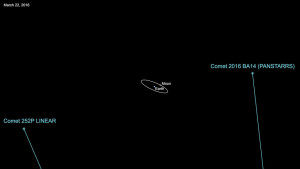
19 March 2016 – As I noted in a previous post, I have been spending more time with NASA’s main web site and all of its corollary/linked sites. Two of them are the NASA Near-Earth Object Program plus the boatload of material coming out of NASA’s Planetary Defense Coordination Office. I am aided by my membership at the Paris Observatory, the foremost astronomical observatory of France, and one of the largest astronomical centers in the world.
Yep, tracking near-Earth objects (NEOs) which are any small solar system bodies whose orbits bring them into proximity with Earth. By definition, all NEOs have a closest approach to the Sun (perihelion) of less than 1.3 astronomical unit (AU). They include about thirteen thousand near-Earth asteroids (NEAs), more than one hundred near-Earth comets (NECs), and a number of solar-orbiting spacecraft and meteoroids, large enough to be tracked in space before striking the Earth. It is now widely accepted that collisions in the past have had a significant role in shaping the geological and biological history of the Earth so NEOs have become of increased interest since the 1980s because of increased awareness of the potential danger some of the asteroids or comets pose, and mitigations are being researched.
In January 2016, NASA announced the Planetary Defense Coordination Office to track NEOs larger than 30 to 50 meters in diameter and coordinate an effective threat response and mitigation effort.
Note: the U.S. is currently the only country with an active, government-sponsored effort to detect and track potentially hazardous NEOs.
There are also potentially hazardous objects (PHOs) which are currently defined based on parameters that measure the object’s potential to make threatening close approaches to the Earth. Mostly objects with an Earth minimum orbit intersection distance (MOID) of 0.05 AU or less and an absolute magnitude (H) of 22.0 or brighter (a rough indicator of large size) are considered PHOs.
Fernández Carril, who has written about the subject in some detail, says the perception of risk is “a product of religious belief, philosophic principles, scientific understanding, technological capabilities, and even economical resourcefulness.”
The detection algorithms used, and the data processing systems/pattern recognition systems employed, are the most sophisticated computation capabilities I have ever seen … outside the Large Hadron Collider at CERN.
Consider the task of finding asteroids from images of the day and night skies. The problem is one of connect-the-dots, linking together individual point observations from different times to find those sets of observations that correspond with the same true underlying object. However, the problem becomes more difficult as true associations may be widely spaced in time, skewed by random errors, and buried within a large number of spurious noise observations.
To my litigation support readers who have experience with the new “science” of predictive coding and data analysis, you see the similarities. Underlying this entire problem is the question of finding structure within a set of noisy point observations by extracting new associations and thus new tracks. In large-scale problems such as asteroid tracking, the computational issues rapidly become daunting with a vast number of potential associations to explore.
Jack Kilhane, one of my instructors at CERN, says you are exploring the problem of extracting model-based spatial associations and structure from large amounts of noisy data. In effect two related and intertwined topics: model-based spatial structure search and large-scale asteroid tracking. Both topics are inherently searches for types of spatial structure within the data. The problem of initially finding new asteroids is itself a model-based spatial structure search and will guide the description and development of efficient and general algorithms for a range of spatial association problems.
Full admission: it took me 4 weeks to wrap my mind just around general spatial structure search and my notebook is filled with about 100 cocktail napkins (we seemed to have a lot a classes in a bar in Geneva). But once done, I quickly “fit in” target tracking, computer vision, computational statistics, data mining, and computer graphics. I also (finally) began to understand the use of decision-tree learning algorithms.
More to come.